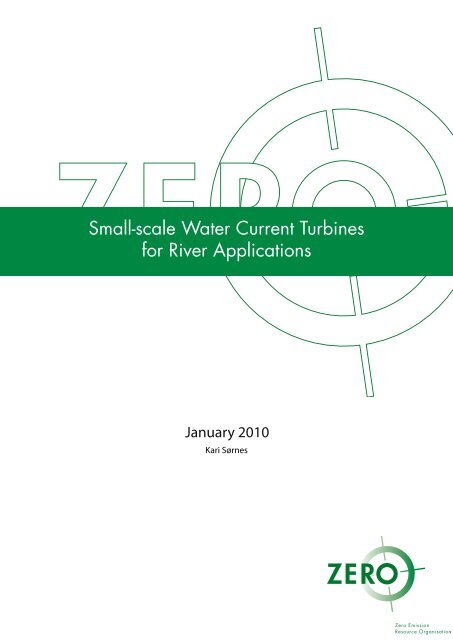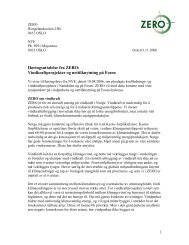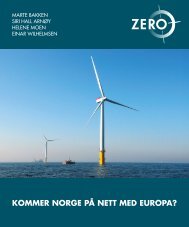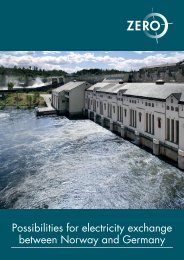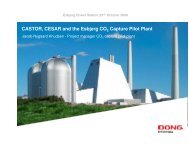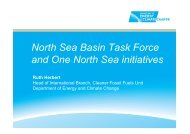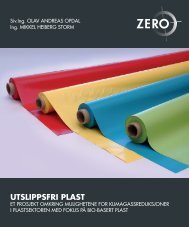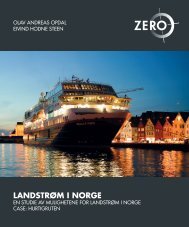Small-scale Water Current Turbines for River Applications - Zero
Small-scale Water Current Turbines for River Applications - Zero
Small-scale Water Current Turbines for River Applications - Zero
You also want an ePaper? Increase the reach of your titles
YUMPU automatically turns print PDFs into web optimized ePapers that Google loves.
<strong>Small</strong>-<strong>scale</strong> <strong>Water</strong> <strong>Current</strong> <strong>Turbines</strong><br />
<strong>for</strong> <strong>River</strong> <strong>Applications</strong><br />
January 2010<br />
Kari Sørnes
About ZERO<br />
<strong>Zero</strong> Emission Resource Organization is an environmental organization dedicated to<br />
reducing climate change by demonstrating and gaining acceptance <strong>for</strong> zero emission<br />
energy solutions. We believe a zero emission solution exists <strong>for</strong> all energy use. Our<br />
mission is to work consistently <strong>for</strong> these solutions.<br />
Contact us at:<br />
ZERO – <strong>Zero</strong> Emission Resoruce Organisation<br />
Maridalsveien 10<br />
0178 Oslo<br />
www.zero.no<br />
zero@zero.no
Table Of Contents<br />
Summary4<br />
1 Introduction 5<br />
21 Conversion and Operation 6<br />
211 Conversion Schemes 6<br />
2 The Technology of <strong>Water</strong> <strong>Current</strong> <strong>Turbines</strong> 6<br />
212 Augmentation 7<br />
213 The Flow of the <strong>River</strong> and Siting Considerations 7<br />
3 Companies and technologies8<br />
32 Companies and concepts 9<br />
321 Thropton Energy Services (UK) 9<br />
322 Alternative Hydro Solutions Ltd (Canada) 10<br />
323 Energy Alliance (Russia)11<br />
324 New Energy Corporation Inc (Canada) 12<br />
325 Seabell International Co, Ltd (Japan) 13<br />
326 Lucid Energy Technologies (US) 14<br />
327 Tidal Energy Pty Ltd (Australia)15<br />
328 Eclectic Energy Ltd (UK) 16<br />
4 Research and experiences 17<br />
5 Discussion 18<br />
6 References 19<br />
ZERO - <strong>Small</strong>-<strong>scale</strong> <strong>Water</strong> <strong>Current</strong> <strong>Turbines</strong> <strong>for</strong> <strong>River</strong> <strong>Applications</strong>
Summary<br />
The purpose of this report is to get an overview of the<br />
existing technology of water current turbines with a<br />
unit power output of about 0.5-5 kW.<br />
<strong>Water</strong> current turbines, or hydrokinetic turbines, produce<br />
electricity directly from the flowing water in a<br />
river or a stream. No dam or artificial head is needed<br />
to produce the small-<strong>scale</strong> power output. Several of<br />
the devices mentioned in the report may have application<br />
in tidal waters, ocean currents and manmade<br />
channels, but the scope of this report is limited to applications<br />
in free-flowing rivers.<br />
Reviews of the most common existing turbine technologies<br />
are outlined. The two most common small<strong>scale</strong><br />
hydrokinetic turbine concepts are axial flow<br />
turbine and cross-flow turbine. Of importance <strong>for</strong> the<br />
power production is whether the turbine is ducted<br />
or not. Where to place the turbine must also be well<br />
considered.<br />
The report summarizes the commercial market<br />
which exists in this field and considers some previous<br />
experiences in rural areas. Several companies from<br />
different parts of the world are presented with their<br />
concept. To find the companies which are established<br />
and emerging within this field, a web-based search is<br />
per<strong>for</strong>med. Previous reports dealing with this subject<br />
are also reviewed.<br />
<strong>Small</strong>-<strong>scale</strong> hydro power from water current turbines<br />
is considered to be reliable and ecologically friendly.<br />
Because of the low cost and the longevity of micro<br />
hydro, developing countries may manufacture and<br />
implement the technology to help supply the needed<br />
electricity to small communities in remote areas.<br />
Discussions on per<strong>for</strong>mance analysis and modelling<br />
issues are beyond the scope of this work.<br />
ZERO - <strong>Small</strong>-<strong>scale</strong> <strong>Water</strong> <strong>Current</strong> <strong>Turbines</strong> <strong>for</strong> <strong>River</strong> <strong>Applications</strong>
1 Introduction<br />
The natural power of a running river or a stream has<br />
been of interest <strong>for</strong> electricity production <strong>for</strong> many<br />
years. The technology of small-<strong>scale</strong> hydro power is<br />
diverse, and different concepts have been developed<br />
and tried out. This report will focus on water current<br />
turbines with a unit power output of about 0.5-5 kW.<br />
These turbines are supposed to be used <strong>for</strong> domestic<br />
electricity applications such as lighting, battery charging,<br />
or <strong>for</strong> the use of a small fridge. The units are<br />
small, cheap and often owned, installed, and used by<br />
a single family.<br />
<strong>Water</strong> current turbines, also called hydro kinetic or<br />
in-stream turbines, have received a growing interest<br />
in many parts of the world. Two main areas where<br />
hydrokinetic devices can be used <strong>for</strong> power generation<br />
purposes are tidal currents and river streams.<br />
This report will focus on water current turbines <strong>for</strong><br />
river applications. These turbines generate power<br />
from the kinetic energy of a flowing stream of water<br />
without the use of a dam or a barrage. <strong>Water</strong> current<br />
turbines can be installed in any flow with a velocity<br />
greater than 0.5 m/s [1]. Because of low investment<br />
costs and maintenance fees, this technology is cost<br />
effective in comparison to other technologies. The<br />
continuous supply of electrical energy is also an advantage<br />
in comparison to solar power or other small<strong>scale</strong><br />
renewable technologies. This kind of small-<strong>scale</strong><br />
hydropower is considered environmentally friendly,<br />
meaning that the water passing through the generator<br />
is directed back into the stream with relatively small<br />
impact on the surrounding ecology.<br />
<strong>Small</strong>-<strong>scale</strong> water current turbines can be a solution<br />
<strong>for</strong> power supply in remote areas. Because of the low<br />
cost and durability of this kind of hydro power, developing<br />
countries can manufacture and implement<br />
the technology to supply the needed electricity to<br />
small communities and villages [2].<br />
There are different kinds of small-<strong>scale</strong> hydropower.<br />
The term “pico hydropower” is said to be water power<br />
up to 5kW and is a smaller version of the more established<br />
term; micro hydropower. Pico hydropower is<br />
usually used when we think of hydropower on a regular<br />
basis, where the power is made by falling water and<br />
an artificial water-head. The report will not consider<br />
this type of hydropower. The report will mainly focus<br />
on kinetic “in-stream” hydro turbines. These turbines<br />
produce electricity from the free-flowing water in a<br />
river or stream and do not rely upon a water-head to<br />
produce electricity.<br />
For the scope of this report the focus was on applications<br />
in free-flowing rivers, although several of the<br />
devices may have applications in tidal waters, ocean<br />
currents and man-made channels.<br />
Short reviews of some of the existing turbine technologies<br />
are outlined. The paper will also look at the<br />
commercial market in this field and consider some<br />
experiences already made in rural areas in different<br />
parts of the world. In order to find the existing technologies<br />
and companies with viable concepts, a webbased<br />
search is accomplished. Earlier written reports<br />
are also reviewed.<br />
Discussions on per<strong>for</strong>mance analysis and modelling<br />
issues are beyond the scope of this work.<br />
This report have been made with financial support<br />
from Norad - Norwegian Agency <strong>for</strong> Development<br />
Cooperation.<br />
ZERO - <strong>Small</strong>-<strong>scale</strong> <strong>Water</strong> <strong>Current</strong> <strong>Turbines</strong> <strong>for</strong> <strong>River</strong> <strong>Applications</strong>
2 The Technology of <strong>Water</strong> <strong>Current</strong> <strong>Turbines</strong><br />
<strong>Water</strong> current turbines, or hydrokinetic turbines,<br />
produce electricity directly from the flowing water<br />
in a river or a stream. The energy flux of the water<br />
stream is dependent on the density, cross-sectional<br />
area and velocity cubed (eq. 2.0.1). A number of different<br />
concepts have been developed to utilise this<br />
power throughout the world. While turbine systems<br />
are considered prime choices <strong>for</strong> such conversion,<br />
other non-turbine possibilities are also being pursued<br />
with interest. At present, the non-turbine systems are<br />
mostly at the prototype stage. [3] This report will thus<br />
exclusively focus on turbine systems.<br />
P = Power (watt)<br />
ρ = <strong>Water</strong> density (kg/m3)<br />
C k = Power coefficient<br />
A = Turbine area ( m2)<br />
V = Velocity of water (m/s)<br />
(2.0.1)<br />
2.1 Conversion and Operation<br />
When considering the possible use of a water current<br />
turbine on river applications, several issues are<br />
of concern with regards to the power production per<strong>for</strong>mance.<br />
The next chapter will give a general introduction<br />
to the technology of this field.<br />
2.1.1 Conversion Schemes<br />
Several hydrokinetic conversion concepts have been<br />
developed through the years. The two most common<br />
small-<strong>scale</strong> hydrokinetic turbine concepts are<br />
axial flow turbine and cross-flow turbine. The axial<br />
concept has a rotational axis of rotor which is paral-<br />
Figure 2.1.1.1: Axial-flow (horizontal) turbines [4]<br />
ZERO - <strong>Small</strong>-<strong>scale</strong> <strong>Water</strong> <strong>Current</strong> <strong>Turbines</strong> <strong>for</strong> <strong>River</strong> <strong>Applications</strong><br />
Figure 2.1.1.2: Cross-folw turbines [4]<br />
lel to the incoming water stream. This is illustrated<br />
in figure 2.1.1.1. The inclined axis turbines (a) have<br />
mostly been studied <strong>for</strong> small river energy converters.<br />
The horizontal axis (b, c and d) turbines are common<br />
in tidal energy converters and are very similar to modern<br />
day wind turbines from design and structural<br />
point of view. [4]<br />
The cross-flow concept on the other hand, has a rotational<br />
axis of rotor which is parallel to the water<br />
surface, but orthogonal to the incoming water stream<br />
[3]. The advantage of cross-flow turbines is that they<br />
can rotate unidirectional even with bi-directional fluid<br />
flow. They can be divided into two groups:<br />
1. Vertical axis, with an axis vertical to the water<br />
plane. Different types are illustrated in figure 2.1.1.2.<br />
In the vertical axis domain, the use of H-Darrieus or<br />
Squirrel Cage Darrieus is rather common. Instances<br />
of Darrieus turbines being used to produce hydropower<br />
are nearly non-existent. The Gorlov turbine<br />
is another member of the vertical axis family, where<br />
the blades are of helical structure. Savonious turbines<br />
are “drag type” devices, which may consist of straight<br />
or skewed blades. The disadvantages associated with<br />
vertical axis turbines are: low starting torque, torque<br />
ripple, and lower efficiency. [4] These turbines may<br />
not be self-starting and there<strong>for</strong>e some kind of external<br />
starting mechanisms need to be adopted.<br />
2. In-plane axis, with an axis on the horizontal<br />
plane of the water surface. These are better known as<br />
floating waterwheels. The in-plane turbines are mainly<br />
drag based devices and said to be less efficient than<br />
their lift based counterparts. The large amount of ma-
terial usage can be another problem <strong>for</strong> such turbines.<br />
[4]<br />
Axial flow turbines are self-starting and the issue of<br />
start up is not significant. However, they come with<br />
a price of higher system cost owing to the use of submerged<br />
generator or gearing equipment. Vertical axis<br />
turbines, especially the H-Darrieus types with two or<br />
three blades are reasonably efficient and simpler in<br />
design, but not self-starting. Mechanisms <strong>for</strong> starting<br />
these rotors from a stalled state could be devised from<br />
mechanical or electromechanical perspectives. [15]<br />
2.1.2 Augmentation<br />
Whether the turbine is ducted or not is of great importance<br />
<strong>for</strong> the per<strong>for</strong>mance of the turbine. Ducts<br />
or diffusers are engineered structures that elevate<br />
the energy density of a water stream as observed by<br />
a hydrokinetic converter [3]. The duct, or augmentation<br />
channel, increases the possible total power<br />
capture significantly. In addition, it may help regulate<br />
the speed of the rotor and reduce problems caused by<br />
low-speed drive train design. A consideration <strong>for</strong> these<br />
devices is of high significance primarily because of<br />
two opposing reasons. First, there is the potential of<br />
increasing the power capacity, and hence reduce the<br />
cost of energy. On the other hand, there may be a lack<br />
of confidence concerning their survivability and design<br />
[3]. Figure 2.1.2.1 illustrates some of the types.<br />
Figure 2.1.2.1: Examples of ducts/diffusers [4]<br />
2.1.3 The Flow of the <strong>River</strong> and Siting<br />
Considerations<br />
The best per<strong>for</strong>mance and the highest power production<br />
is made by a smooth linear flow of water at high<br />
velocity [5]. The flow characteristic of a river stream<br />
has a stochastic variation, both seasonal and daily, and<br />
where to put the water current turbine must there<strong>for</strong>e<br />
be well considered. A positive aspect of the flow of<br />
rivers is that it is unidirectional, which eliminates the<br />
requirement <strong>for</strong> rotor yawing.<br />
For a hydrokinetic converter, the level of power output<br />
is directly related to flow velocity. The volumetric<br />
flow in<strong>for</strong>mation may be available <strong>for</strong> the location,<br />
but the water velocity varies from one potential site to<br />
the other depending on the cross-sectional area. [3]<br />
The placement of a hydrokinetic device, in relation<br />
to a channel cross-section, is a very significant component<br />
<strong>for</strong> two basic reasons. First of all, the energy<br />
flux in the surface of a stream is higher than that of<br />
the stream on the bottom. In addition, this quantity<br />
takes diverse values depending on the distance from<br />
the shore. In a smooth channel, the water current is<br />
fastest at the centre, but in a river this may vary depending<br />
of the bottom. There<strong>for</strong>e, the water velocity<br />
has a localized and site-specific profile, and where the<br />
rotor is located dictates the amount of energy that can<br />
be produced. [3] Second, in a river there are competing<br />
users of the water stream. This could be boats,<br />
fishing vessels, bridges, etc., and these might reduce<br />
the effective usable area <strong>for</strong> a turbine installation [6].<br />
There could also be varying types of suspended particles<br />
and materials like fish, rock, ice, etc. in the river<br />
[4].<br />
Properly placing a hydrokinetic turbine requires an<br />
understanding of what influences the kinetic energy<br />
or velocity of the water at any point in the river. This<br />
can be studied further in the report Siting Considerations<br />
<strong>for</strong> Kinetic (In-Stream) Hydro <strong>Turbines</strong> made<br />
by ABS Alaskan, Inc [5].<br />
ZERO - <strong>Small</strong>-<strong>scale</strong> <strong>Water</strong> <strong>Current</strong> <strong>Turbines</strong> <strong>for</strong> <strong>River</strong> <strong>Applications</strong>
8<br />
3 Companies and technologies<br />
To find the companies that are established and emerging<br />
within this field, a web-based search was per<strong>for</strong>med.<br />
Earlier written reports dealing with this subject<br />
were also reviewed. Especially a report about the<br />
technical status in 2006 made by Verdant Power [6] is<br />
used to list the present companies.<br />
Company<br />
Thropton<br />
Energy<br />
Services<br />
(UK)<br />
Alternative<br />
Hydro Solutions<br />
Ltd<br />
(Canada)<br />
Energy<br />
Alliance<br />
(Russia)<br />
New<br />
Energy<br />
(Canada)<br />
Tidal<br />
Energy<br />
Pty. Ltd.<br />
(Australia)<br />
Lucid<br />
Energy<br />
Technologies<br />
(USA)<br />
Seabell Int.<br />
Co., Ltd.<br />
(Japan)<br />
Eclectic<br />
Energy<br />
Ltd. (UK)<br />
WCT<br />
Device<br />
Name<br />
<strong>Water</strong><br />
<strong>Current</strong><br />
Turbine<br />
Freestream<br />
Darrieus<br />
<strong>Water</strong><br />
Turbine<br />
Submerged<br />
Hydro<br />
Unit<br />
En<strong>Current</strong><br />
Hydro<br />
Turbine<br />
TBD<br />
Gorlov<br />
Helical<br />
Turbine<br />
STREAM<br />
DuoGen<br />
Turbine<br />
Type<br />
Axis flow<br />
propeller<br />
Crossaxis<br />
Crossaxis<br />
Crossaxis<br />
Darrieus,<br />
Crossaxis<br />
Helical<br />
Darrieus<br />
Crossaxis<br />
Dual,<br />
Crossaxis<br />
Axial<br />
flow propeller<br />
Stage of<br />
Development<br />
Commercial<br />
Commercial<br />
Commercial<br />
Commercial<br />
Pre-commercial<br />
Commercial<br />
Commercial<br />
Commercial<br />
Companies and technology summary table<br />
Min/Max<br />
Depth<br />
(m)<br />
Min 0.<br />
MIn 0.<br />
<strong>for</strong> high<br />
speed<br />
stream<br />
0. /<br />
no limit<br />
MIn 2.<br />
No data<br />
found<br />
Vert: no<br />
limit.<br />
Horiz.:<br />
~1.1<br />
0. /no<br />
limit<br />
0. /no<br />
limit<br />
Min/Max<br />
Speed<br />
(m/s)<br />
0. /<br />
depends<br />
on<br />
diameter<br />
0. /<br />
depends<br />
on<br />
diameter<br />
Table 3.1 gives a summary of the concepts that are<br />
in a commercial or pre-commercial stage today. Precommercial<br />
means that it has done a demonstration<br />
of a commercial size unit. Commercial means that<br />
there are units commercially available. No device on<br />
a laboratory or prototype stage is considered.<br />
Axis of<br />
Rotation<br />
Horiz<br />
Vert<br />
Min Horiz<br />
Min 0. /<br />
<strong>for</strong> max<br />
power<br />
No data<br />
found<br />
0. /no<br />
limit<br />
0. /no<br />
limit<br />
1/ (1.8<br />
knots/9<br />
knots)<br />
Blade diameter<br />
.0, . ,<br />
2.8, 2.2,<br />
1.8 m<br />
1.2 , 1. ,<br />
2. , .0<br />
m<br />
No data<br />
found<br />
No. of<br />
<strong>Turbines</strong><br />
per Unit<br />
One<br />
One<br />
Vert 1. 2 m One<br />
Ducted<br />
or Unducted<br />
Unducted<br />
Unducted<br />
One Ducted<br />
Unducted<br />
Vert 1.2 to 2. One Ducted<br />
Either<br />
Vert<br />
No data<br />
found<br />
No data<br />
found<br />
One or<br />
more<br />
sections<br />
Horiz 0. 1 m One<br />
Unducted<br />
Two Ducted<br />
Unducted<br />
Anchor<br />
System<br />
Pontoon,<br />
boat<br />
Customerdetermined<br />
Weighted<br />
base<br />
and<br />
cabled<br />
Floating<br />
buoy<br />
with<br />
cables to<br />
anchors<br />
Moored<br />
to the<br />
ground<br />
Various<br />
Floating<br />
buoy<br />
with<br />
cables to<br />
anchors<br />
Pontoon,<br />
boat<br />
Unit<br />
Power<br />
Output<br />
Up to<br />
2kW at<br />
2 0v<br />
Up to<br />
2- kW<br />
1- kW<br />
(and >10<br />
kW)<br />
kW<br />
(and ><br />
10kW)<br />
Depends<br />
on velocity<br />
and<br />
size<br />
Up to<br />
20kW,<br />
depends<br />
on size<br />
Undefiend(small<strong>scale</strong>)<br />
8 amps<br />
at<br />
knots<br />
Table 3.1: Companies and technology summary table<br />
NOTE: Most of the in<strong>for</strong>mation presnted is gathered from the cpmåany’s own websites or published litterature without thrid party<br />
confirmation and should be evaluated in light of each design-developer’s experience and track record of date.<br />
ZERO - <strong>Small</strong>-<strong>scale</strong> <strong>Water</strong> <strong>Current</strong> <strong>Turbines</strong> <strong>for</strong> <strong>River</strong> <strong>Applications</strong>
3.2 Companies and concepts<br />
As may be read from table 3.1, there are several companies<br />
with viable concepts within this field. In the<br />
following chapter, the companies and a short outline<br />
of their concepts will be presented.<br />
3.2.1 Thropton Energy Services (UK)<br />
Thropton Energy Services provide a complete range<br />
of services relevant to water current turbines from<br />
resource assessment to design and supply local manufacture.<br />
The company claims to have twenty years<br />
of experience in this field and have worked in UK,<br />
Sudan, Somalia, Egypt and Peru.<br />
The company is the designer and manufacturer of the<br />
Garman turbine, which can be used <strong>for</strong> both water<br />
pumping and electricity generation. The turbine is<br />
axial and can be thought of as an underwater windmill<br />
which floats on a river or canal with the rotor<br />
completely submerged. It is moored in free stream to<br />
a post on one bank, making installation simple and<br />
cheap and minimising obstruction to river traffic. The<br />
propeller fan style turbine, available in diameters of<br />
4.0, 3.4, 2.8, 2.2, and 1.8m drives an above-water generator.<br />
The turbines are stand-alone units and have a maximum<br />
power output of about 2kW. To keep the capital<br />
cost down, Thropton has designed the turbine so that<br />
it can be locally manufactured. Garman turbines are<br />
being manufactured in Sudan, where they are used<br />
<strong>for</strong> pumping irrigation and drinking water from the<br />
Nile and <strong>for</strong> electricity generation. The systems are<br />
said to be easily deployed without heavy equipment,<br />
and thus they are suitable <strong>for</strong> use in developing countries.<br />
Minimum site requirements are a water current speed<br />
of at least 0.5m/s and a depth of 1.75m or more. [1]<br />
Price per unit:<br />
Available on request<br />
Contact in<strong>for</strong>mation:<br />
Dr. B Sexon<br />
Thropton Energy Services<br />
Physic Lane, Thropton,<br />
Northumberland NE65 7HU,United Kingdom<br />
Tel: +44 1669 621288<br />
E-mail: enqs@throptonenergy.co.uk<br />
Web page: http://www.throptonenergy.co.uk/<br />
ZERO - <strong>Small</strong>-<strong>scale</strong> <strong>Water</strong> <strong>Current</strong> <strong>Turbines</strong> <strong>for</strong> <strong>River</strong> <strong>Applications</strong><br />
9
3.2.2 Alternative Hydro Solutions Ltd. (Canada)<br />
Alternative Hydro Solutions Ltd. has taken the Darrieus<br />
concepts and modified them to be more suitable<br />
<strong>for</strong> smaller rivers.<br />
These small Darrieus turbines are, according to Alternative<br />
Hydro Solutions Ltd., constructed of high<br />
quality and durable materials. The turbine blades are<br />
made of aluminium with a solid cross-section in order<br />
to provide the required strength.<br />
A number of electrical options are available depending<br />
on site requirements. These include a permanent<br />
magnet D.C. generator and a brushless alternator.<br />
The turbine is available in several diameters: 1.25<br />
m, 1.5m, 2.5 m, 3.0 m, and 6.0 m, each available in<br />
custom lengths. [6]<br />
The water flow speed that is generally accepted as the<br />
minimum <strong>for</strong> power production is 0.8 m/s [7]. The efficiency<br />
curves illustrated below indicates the power<br />
versus velocity <strong>for</strong> various combinations of diameter<br />
and height.<br />
The company make several different sizes based on<br />
the customer needs. The 2m height by 3m diameter<br />
one has a cross sectional area of 6m^2 and will<br />
produce 750W at 1m/s. The turbine itself goes into a<br />
2.5m by 2.5m by 0.5m box and assembles at site. It<br />
weighs about 200kg. If there was a known place some<br />
assembly could be done closer to site but this would<br />
only be of the bearing and shaft/ generator section.<br />
Price per unit:<br />
Depends on size.750 W (at 1m/s): cen $ 5000<br />
Contact in<strong>for</strong>mation:<br />
Alternative Hydro Solutions Ltd.,<br />
Suite 421, 323 Richmond Street East, Toronto,<br />
Ontario, M5A 4S7, Canada<br />
Tel: 416 368 5813<br />
E-mail: sdgregory@althydrosolutions.com<br />
Web page:http://www.althydrosolutions.com/<br />
10 ZERO - <strong>Small</strong>-<strong>scale</strong> <strong>Water</strong> <strong>Current</strong> <strong>Turbines</strong> <strong>for</strong> <strong>River</strong> <strong>Applications</strong>
3.2.3 Energy Alliance (Russia)<br />
Energy Alliance has a concept based on a in-plane,<br />
cross-axis turbine. A stream-flow having sufficient<br />
width, depth and velocities of about 3 m/s can be<br />
used <strong>for</strong> installation of the submerged turbine. At<br />
higher velocity, higher output can be obtained with<br />
the hydro-unit overall dimensions unchanged.<br />
The turbine is housed in a duct that allows the system<br />
to be placed in a swift flowing river without the use of<br />
a dam. The units are expected to stay reliably secured<br />
by hydraulic and hydrodynamic <strong>for</strong>ces. The submerged<br />
units can be operated year round, including the<br />
case when they are installed in the rivers with incomplete<br />
freezing of the river bed. The Energy Alliance<br />
plans to produce two versions of submerged hydrounits<br />
- portable units with outputs from 1 to 5 kW and<br />
stationary units with outputs from 10 kW to 225kW.<br />
The portable submerged hydro-units are intended <strong>for</strong><br />
generation of 12V and 28V direct current, depending<br />
on the parameters of stream flow and generator type.<br />
[8] The turbines are currently in production [6].<br />
Price per unit:<br />
Tentative price <strong>for</strong> up to 16kW: 12800 USD<br />
(Jan 2010)<br />
Contact in<strong>for</strong>mation:<br />
Energy Alliance,<br />
198095, St. Petersburg, Obvodny Kanal 122, Russia<br />
Tel: 259-91-27 Fax: 113-02-07<br />
E-mail: mail@energy-alliance.spb.ru<br />
Web page:<br />
http://in<strong>for</strong>mal.ru/www.energy-alliance.spb.ru/sinke.htm<br />
ZERO - <strong>Small</strong>-<strong>scale</strong> <strong>Water</strong> <strong>Current</strong> <strong>Turbines</strong> <strong>for</strong> <strong>River</strong> <strong>Applications</strong><br />
11
3.2.4 New Energy Corporation Inc. (Canada)<br />
New Energy Corporation Inc., with support from<br />
Natural Resources Canada and the CANMET Energy<br />
Technology Centre, have developed a series of turbine/generator<br />
sets that produce between 5 kW and 25<br />
kW of power and are supposed to be used in rivers,<br />
irrigation canals, industrial outflows, and tidal estuaries.<br />
The En<strong>Current</strong> generator is based on the vertical<br />
axis hydro turbine. It employs hydrofoils mounted<br />
parallel to a vertical shaft which drives a permanent<br />
magnet generator, with all electrical equipment mounted<br />
above the water surface.[9]<br />
According to the website of the company, the 5 kW<br />
En<strong>Current</strong> Power Generation System generates<br />
enough electricity to power two to five average homes<br />
on a continuous basis and is available in a standalone<br />
or grid connected configuration. The system<br />
is available in three models: A high velocity model<br />
(5 kW power output at 3 m/s), low velocity model<br />
(5 kW power output at 2.4 m/s) and restricted flow<br />
model. The restricted flow model uses a five bladed<br />
turbine which increases the resistance in the turbine.<br />
It is used in locations where the majority of the water<br />
in the channel flows through the turbine and where<br />
the increased resistance causes water to accumulate<br />
behind the turbine. [10]<br />
ABS Alaskan delivers the En<strong>Current</strong> systems. Every<br />
En<strong>Current</strong> turbine is sold as a complete “water to<br />
wire” package, including appropriate inverters <strong>for</strong> the<br />
system type [11]. Overall system mass <strong>for</strong> a 5kW turbine<br />
is 340-360 kg and the height is 2.25 m. Shipping<br />
charges will be clarified by request, depending on how<br />
many devices that are ordered and where they are to<br />
be delivered. The economic payback <strong>for</strong> the system is<br />
promised to be as little as two years.<br />
Price per unit:<br />
For a 5kW turbine: 28000 USD (Jan 2010)<br />
Contact in<strong>for</strong>mation:<br />
New Energy Corporation Inc.<br />
3553 - 31 Street NW, Suite 473 Calgary,<br />
Alberta, T2L 2K7, Canada<br />
Tel: (403) 260-5240<br />
Email: info@newenergycorp.ca<br />
Webpage: http://www.newenergycorp.ca<br />
Main supplier:<br />
Abs Alaskan, Inc: www.absAK.com<br />
Technical Product Questions: tech@absak.com<br />
General Sales Questions: sales@absak.com<br />
Shipping Questions: shipping@absak.com<br />
12 ZERO - <strong>Small</strong>-<strong>scale</strong> <strong>Water</strong> <strong>Current</strong> <strong>Turbines</strong> <strong>for</strong> <strong>River</strong> <strong>Applications</strong>
3.2.5 Seabell International Co., Ltd. (Japan)<br />
According to Seabell International Co website, The<br />
STREAM is the world’s first invention of a «Dual axis<br />
turbine» (flat type, dual vertical axis), with an opposite<br />
rotation accelerating gear system and a system that<br />
reduces friction loss.<br />
The current speed accelerates by taking in a large<br />
mass of natural non-head water current into the axel<br />
chamber. The smooth inflow/outflow design is supposed<br />
to minimize hydraulic head loss (friction) and<br />
capture energy efficiently.<br />
The generator is mounted above the waterline, and<br />
this reduces manufacturing and maintenance costs.<br />
It is always suspended on the water surface, where the<br />
fastest current speed is, thus the largest concentration<br />
of energy exists in rivers and water ducts.<br />
Employing dual axis structure taking into account<br />
flow behaviour of ducts, where the largest energy always<br />
exists at the centre. [12]<br />
Price per unit:<br />
Available on request<br />
Contact in<strong>for</strong>mation:<br />
Seabell International Co<br />
Mansan Building 2-8-11 Higashi-kanda, Chiyoda-ku,<br />
Tokyo, Japan 101-0031<br />
Tel: +81-35822-2275<br />
Fax: +81-35822-2274<br />
E-mail: info@seabell-i.com<br />
Web page: http://www.seabell-i.com/e/<br />
ZERO - <strong>Small</strong>-<strong>scale</strong> <strong>Water</strong> <strong>Current</strong> <strong>Turbines</strong> <strong>for</strong> <strong>River</strong> <strong>Applications</strong><br />
1
1<br />
3.2.6 Lucid Energy Technologies (US)<br />
Until 2007, GCK was the licensee of the Gorlov Helical<br />
Turbine (GHT) patents and technology. Then<br />
GCK Technology entered into a Joint Venture Agreement<br />
in March of 2007 to <strong>for</strong>m Lucid Energy Technologies.<br />
All business relating to the GHT Technology<br />
is now being conducted through Lucid Seabell<br />
International Co [13].<br />
GHT is a cross-axis turbine consisting of one or more<br />
long helical blades that run along an imaginary cylindrical<br />
surface of rotation like a screw thread. The design<br />
made by Alexander M. Gorlov developed at the<br />
North-eastern University, Boston, U.S.A has gained<br />
significant attention <strong>for</strong> both river and tidal applications<br />
[4]. Gorlov and co-workers in the United States<br />
tested models of the cross-flow turbine with helical<br />
blades and claim that its per<strong>for</strong>mance is superior to<br />
a conventional Darrieus cross flow turbine. The picture<br />
to the left shows two different examples of the<br />
concept.<br />
The generated capacity is said to be proportional to<br />
the number of modules. In its vertical orientation the<br />
generator and gearing can easily be positioned above<br />
water. It starts producing power at approximately 0.60<br />
m/s, according to studies done in 2004.[6]<br />
According to Lucid, the Airfoil-shaped blades move<br />
at twice the speed of the current and the components<br />
can be assembled and replaced on-site. The aluminium<br />
construction is lightweight, rustproof, and recyclable.[13<br />
Price per unit:<br />
Available on request<br />
Contact in<strong>for</strong>mation:<br />
Lucid Energy Technologies 118 East Washington<br />
Street, Suite 2 Goshen,<br />
IN 46528, US<br />
Tel: (574) 537-7300<br />
E-mail: Unknown<br />
Web page: http://www.lucidenergy.com<br />
ZERO - <strong>Small</strong>-<strong>scale</strong> <strong>Water</strong> <strong>Current</strong> <strong>Turbines</strong> <strong>for</strong> <strong>River</strong> <strong>Applications</strong>
3.2.7 Tidal Energy Pty. Ltd. (Australia)<br />
Tidal Energy is a company that was <strong>for</strong>med in 1998.<br />
Despite the fact that the scope of this report was to focus<br />
on applications in free-flowing rivers and not on<br />
tidal energy, the concept is considered because of the<br />
possible use in tidal streams like the Amazon <strong>River</strong>.<br />
According to the firm, flows around 2 m/s are ideal<br />
<strong>for</strong> electricity production with this turbine. The concept<br />
is pre-commercial, but Tidal Energy is offering<br />
demonstration turbines <strong>for</strong> sale or lease.[14]<br />
Price per unit:<br />
Capacity at 0.77-6.16 kW (1-2m/s): 35 000 AU$<br />
(Jan 2010)<br />
Contact in<strong>for</strong>mation:<br />
Tidal Energy Pty. Ltd.<br />
Bill Maywes, Australia<br />
SKYPE. bmeywes (preferred)<br />
Tel: +61 401 052 522.<br />
E-mail: bill@tidalenergy.net.au<br />
Web page: http://www.tidalenergy.net.au<br />
ZERO - <strong>Small</strong>-<strong>scale</strong> <strong>Water</strong> <strong>Current</strong> <strong>Turbines</strong> <strong>for</strong> <strong>River</strong> <strong>Applications</strong><br />
1
1<br />
3.2.8 Eclectic Energy Ltd. (UK)<br />
The DuoGen is a combined water and wind mill. It<br />
is made to produce electricity to run most of the onboard<br />
equipment when sailing a yacht. Although this<br />
kind of technology is not in the scope of this report, it<br />
is considered because of the possibility of using it in a<br />
river or a stream.<br />
The picture to the left shows when DuoGen is in its<br />
water mode. The DuoGen water mode is said to operate<br />
in a controlled fashion within the top 500mm of<br />
the water. This, coupled with the design of the threebladed<br />
impeller, ensures that drag is minimised. [19]<br />
Several wind/water combinations are available on the<br />
market, but Eclectic Energy claim that they tend to be<br />
adaptations of single purpose machines and are characterised<br />
by being problematic to deploy and recover.<br />
DuoGen is supposed to be easy and efficient.<br />
Price per unit:<br />
Short Tower (1.3 metre): £1699.00 (including VAT)<br />
Long Tower (1.6 metre): £1749.00 (including VAT)<br />
Extra Long Tower (1.85 metre): £1849.00 (including<br />
VAT)<br />
(Jan 2010)<br />
Contact in<strong>for</strong>mation:<br />
Eclectic Energy Ltd. Edwinstowe<br />
House High Street, Edwinstowe,<br />
Nottinghamshire, NG21 9PR , United Kingdom<br />
Tel: +44 1623 827829<br />
E-mail: webmaster@eclectic-energy.co.uk<br />
Web page: http://www.eclectic-energy.co.uk/<br />
ZERO - <strong>Small</strong>-<strong>scale</strong> <strong>Water</strong> <strong>Current</strong> <strong>Turbines</strong> <strong>for</strong> <strong>River</strong> <strong>Applications</strong>
4 Research and experiences<br />
The technology of small-<strong>scale</strong> hydro power is still<br />
in the stage of development and the possibilities are<br />
not yet fully explored. <strong>Small</strong>-<strong>scale</strong> hydro power has a<br />
growing interest around the world, and different concepts<br />
have been tried out with various outcomes.<br />
As mentioned, the company Thropton Energy Service<br />
has twenty years of experience in the field of hydrokinetic<br />
turbines and have worked in UK, Sudan,<br />
Somalia, Egypt and Peru. They claim to have success<br />
in implementing their technology in remote areas<br />
and have done a case study where a farmer in Sudan<br />
got irrigation water <strong>for</strong> his 12 acre of land relying on<br />
their Garman turbine. The turbine replaced an earlier<br />
diesel engine powered system which required continuous<br />
supplies of fuel and oil which can be difficult<br />
to obtain in isolated areas. Eighteen months after the<br />
installation, the farm was visited by Thropton Energy<br />
Services staff. The turbine was working to the farmer’s<br />
satisfaction and had at that time run <strong>for</strong> more than<br />
11,000 hours without breakdown and without any<br />
spare part being fitted. [21]<br />
At the web site of New Energy Corporation, a case study<br />
of a 5 kW En<strong>Current</strong> Power Generation System is<br />
presented [22]. Electricity from the turbine started to<br />
flow into the micro-grid in Ruby, Alaska on August,<br />
2008. Ruby is a community of approximately 200 residents<br />
located on the Yukon <strong>River</strong> in central Alaska.<br />
Electricity generation <strong>for</strong> the community is currently<br />
provided by diesel local tank farm, but the area has a<br />
large potential <strong>for</strong> hydrokinetic industry due to the<br />
high energy costs and abundant river and tidal resources.<br />
The system at Ruby has validated the concept<br />
of installing hydrokinetic turbines and producing power<br />
to micro-grids in Alaska. It is now being monitored<br />
<strong>for</strong> per<strong>for</strong>mance, grid integration, fisheries and<br />
navigation issues. These findings will then be used to<br />
further improve and perfect the hydrokinetic system.<br />
[22]<br />
Another demonstration, with a Gorlov-type turbine<br />
was done in the Amazon, by a non-profit organization<br />
called IPAM, a Brazilian NGO. For the prototype<br />
at this site, it was expected that the energy produced<br />
would be sufficient to meet the basic needs of 10 households,<br />
at World Bank standards <strong>for</strong> rural electrification<br />
using solar energy. [18]<br />
In order to capture the energy of the tides near the<br />
mouth of the Amazon <strong>River</strong> in Brazil, a prototype<br />
station was built, with characteristics adapted <strong>for</strong><br />
small-<strong>scale</strong> generation of electricity in a rural area.<br />
The photograph shows a six-blade version of the<br />
helical turbine used at the station. This turbine was<br />
built locally by a mechanic and a welder. The only<br />
outside components were the helical turbine blades<br />
themselves.[18] If this technology proves viable in the<br />
pilot phase, the organization expect that hundreds of<br />
small, tide-powered generating stations will be built<br />
near the mouth of the Amazon and elsewhere along<br />
the adjacent Atlantic coast. The organization claims<br />
that because the technology is accessible, af<strong>for</strong>dable,<br />
and inherently small-<strong>scale</strong>, these stations can be built,<br />
owned, and operated by hundreds of rural residents.<br />
The people could use the energy <strong>for</strong> themselves and<br />
also offer battery charging service to their neighbours.<br />
The project started in 2006. The author has not been<br />
successful in providing a temporarily status report.<br />
In<strong>for</strong>mation on several designs with horizontal and<br />
vertical axis rotors that were tested in the Amazon<br />
regions of Brazil could be found in [24]. The report<br />
summarizes the status of the use of small-<strong>scale</strong> hydrokinetic<br />
technology in the the region up to 2003.<br />
According to the report, the most successful experiences<br />
in the Brazilian area were done by a research<br />
group from the Department of Mechanical Engineering<br />
at the University of Brasilia. Several experiences<br />
with diverse prototypes of vertical and axial turbines<br />
were per<strong>for</strong>med, as is further discussed in the paper<br />
Hydrokinetic Turbine <strong>for</strong> Isolated Villages [25]. The<br />
article conclude with that the hydrokinetic turbines<br />
presented in the paper are functioning, produce stable<br />
electrical energy at 220 volts and permits the use<br />
of domestic equipment. The developed technology<br />
proved to be robust and suitable <strong>for</strong> the extremely<br />
severe conditions of the remote and isolated villages,<br />
since it had been functioning uninterruptedly <strong>for</strong> seven<br />
years. The hydrokinetic power plant that was tested<br />
typically provided up to 2kW of electric power,<br />
depending on river characteristics. It was considered<br />
a reliable alternative <strong>for</strong> the electrification of isolated<br />
households and communities.<br />
Research results on inclined axis turbines have been<br />
reported in the articles [26] and [27]. In these works,<br />
the feasibility of utilizing river energy in Bangladesh<br />
was studied, and conclusions were drawn in favour of<br />
ZERO - <strong>Small</strong>-<strong>scale</strong> <strong>Water</strong> <strong>Current</strong> <strong>Turbines</strong> <strong>for</strong> <strong>River</strong> <strong>Applications</strong><br />
1
such technologies. The effects of varying blade pitch<br />
and shaft inclination angle were also studied and the<br />
average mechanical system efficiency was reported to<br />
be 30%[15].<br />
The latter report, along with other research done in<br />
this field, is listed in the article <strong>River</strong> current energy<br />
conversion systems: Progress, prospects and challenges<br />
from 2007 [15]. The article may serve as a literature<br />
survey or technology review, and may provide<br />
better understanding of the issues and research interests<br />
in the field of water current technology. Some<br />
of the designs mentioned are patented technologies<br />
meant <strong>for</strong> large <strong>scale</strong> energy conversion, but much of<br />
the knowledge can also be used <strong>for</strong> small-<strong>scale</strong>d technology.<br />
When doing literature search <strong>for</strong> this report, research<br />
results, experiments and case studies with well documented<br />
controls were hard to find. A website called<br />
International <strong>Small</strong> Hydro is a new site that is supposed<br />
to provide data <strong>for</strong> potential and developed small<strong>scale</strong><br />
hydro sites [17]. The site also describes the stages<br />
of planning that are required to determine if a site<br />
is technically and economically feasible. This can be a<br />
good source of in<strong>for</strong>mation <strong>for</strong> future projects.<br />
5 Discussion<br />
Unlike conventional hydro and tidal barrage installations,<br />
water current turbines in open flow can generate<br />
power from flowing water with almost zero<br />
environmental impact, over a much wider range of<br />
sites than those available <strong>for</strong> conventional tidal power<br />
generation.<br />
<strong>Small</strong>-<strong>scale</strong> hydropower is especially attractive as an<br />
alternative to highly polluting and costly diesel generation<br />
that provides electric energy in remote communities<br />
across the world. Since many remote communities<br />
are situated near moving water these turbines<br />
represent a promising source of clean power.<br />
Most of the components, such as blade, generator,<br />
power converter, etc., needed <strong>for</strong> designing a turbine<br />
system are mostly readily available. There<strong>for</strong>e, product<br />
development cycle, cost and level of technical<br />
sophistication are expected to be low. [15]<br />
There are several advantages with this kind of technology<br />
compared to other small-<strong>scale</strong> power devices.<br />
As mentioned, it only takes a small amount of flow to<br />
generate electricity. It is reliable in the sense of that<br />
the water stream produces a continuous supply of<br />
18 ZERO - <strong>Small</strong>-<strong>scale</strong> <strong>Water</strong> <strong>Current</strong> <strong>Turbines</strong> <strong>for</strong> <strong>River</strong> <strong>Applications</strong><br />
electrical energy in comparison to other small-<strong>scale</strong><br />
renewable technologies. Also, the peak energy season<br />
is during the winter months when large quantities of<br />
electricity are required [2]. No reservoir is required<br />
and it is considered as a cost effective energy solution<br />
because of the low investment costs and maintenance<br />
fees. <strong>Water</strong> current turbines are there<strong>for</strong>e said to be<br />
an efficient and environmentally friendly technology<br />
<strong>for</strong> small-<strong>scale</strong> energy production. However, there are<br />
certain disadvantages that should be considered be<strong>for</strong>e<br />
constructing a small hydro power system.<br />
First of all, in many locations stream size will fluctuate<br />
seasonally. During the summer months there will<br />
likely be less flow and there<strong>for</strong>e less power output.<br />
Advanced planning and research are needed to ensure<br />
that adequate energy requirements are met [2].<br />
Another issue is that the power efficiency strongly depends<br />
on the location of the turbine. Suitable site characteristics<br />
are required, and their localization may be<br />
complicated and time consuming.<br />
The ecological impact of small-<strong>scale</strong> hydro is minimal,<br />
however the locally environmental effects must<br />
be taken into consideration be<strong>for</strong>e construction begins<br />
[2]. Factors such as possible down-stream flow<br />
alterations and adversities on aquatic plants and animals<br />
should be brought into light [15].<br />
These types of developments can bring about environmental<br />
and socio-economic benefits through<br />
integrated design, multipurpose planning and community<br />
involvement. [2] The turbines can replace<br />
earlier diesel engine powered systems which requires<br />
continuous supplies of fuel and oil. Due to the isolation<br />
of certain areas, obtaining fuel supplies is often a<br />
constant problem. The turbines could potentially provide<br />
several services such as water pumping <strong>for</strong> storage,<br />
livestock, human consumption, small industry,<br />
and irrigation. In such applications, water pumps<br />
could be employed instead of electrical generators, to<br />
facilitate direct mechanical energy conversion. [15]<br />
If the use of this technology in rural areas is to be a<br />
success however, the turbines must be easy to use and<br />
the quality must be reliable.
6 References<br />
[1] Thropton Energy, Physic Lane, Thropton,<br />
Northumberland NE65 7HU, United Kingdom,<br />
January 2010.<br />
http://www.throptonenergy.co.uk/<br />
[2] Alternative Energy, January 2010<br />
http://www.alternative-energy-news.info/<br />
micro%20hydro-power-pros-and-cons/<br />
[3] M.J. Khan, G. Bhuyan, M.T. Iqbal and J.E. Quaicoe;<br />
Hydrokinetic energy conversion systems and<br />
assessment of horizontal and vertical axis turbines<br />
<strong>for</strong> river and tidal applications: A technology status<br />
review, Applied Energy, October 2009, Pages 1823-<br />
1835 (ScienceDirect)<br />
[4] Hydrovolts, January 2010<br />
http://www.hydrovolts.com/MainPages/<br />
Hydrokinetic%20<strong>Turbines</strong>.htm<br />
[5] ABS Alaskan Inc. report, January 2010<br />
Siting Considerations <strong>for</strong> kinetic (In-Stream) Hydro<br />
<strong>Turbines</strong><br />
http://www.absak.com/tech/En<strong>Current</strong>Siting.pdf<br />
[6] Verdant Power, June 2006<br />
Technology Evaluation of Existing and Emerging<br />
Technologies<br />
- <strong>Water</strong> <strong>Current</strong> <strong>Turbines</strong> <strong>for</strong> <strong>River</strong> <strong>Applications</strong><br />
http://www.hydrovolts.com/Refs/Verdant%20<strong>River</strong>%<br />
20<strong>Turbines</strong>%20report.pdf<br />
[7] Alternative Hydro Solutions Ltd., Suite 421, 323<br />
Richmond Street East, Toronto, Ontario, M5A 4S7,<br />
tel: 416.368.5813, January 2010.<br />
http://www.althydrosolutions.com/<br />
[8] Energy Alliance, January 2010<br />
http://in<strong>for</strong>mal.ru/www.energy-alliance.spb.ru/sinke.htm<br />
[9] V. Ginter and C. Bear, New Energy Corporation<br />
Inc.,<br />
Development and Application of a <strong>Water</strong> <strong>Current</strong><br />
Turbine, 2009<br />
http://www.newenergycorp.ca/LinkClick.aspx?filetic<br />
ket=5%2btQK3cID%2fY%3d&tabid=84&mid=471<br />
[10] New Energy Corporation, January 2010<br />
http://www.newenergycorp.ca/Products/<br />
PowerGeneration/5kWPowerGenerationSystem/tabid/69/Default.aspx<br />
[11] ABS Alaskan, January 2010<br />
http://www.absak.com/catalog/product_info.php/<br />
cPath/33_89_90/products_id/1098<br />
[12] Seabell International Co., Ltd, January 2010<br />
http://www.seabell-i.com/e/<br />
[13] Lucid Energy Technologies, January 2010<br />
http://www.lucidenergy.com/<br />
[14] Tidal Energy Pty. Ltd., January 2010<br />
http://www.tidalenergy.net.au/?D=1<br />
[15] M.J. Khan, M.T. Iqbal and J.E. Quaicoe, <strong>River</strong><br />
current energy conversion systems: Progress, prospects<br />
and challenges, Renewable and Sustainable<br />
Energy Reviews, October 2008, Pages 2177-2193<br />
(ScienceDirect)<br />
[16] G. Ranjitkar, J. Huang and T. Tung, Application<br />
of Micro-hydropower Technology <strong>for</strong> Remote Regions,<br />
Hydraulic Energy Program, CANMET Energy<br />
Technology Centre, Natural Resources Canada, 2006<br />
(IEEE: Authorized licensed use limited to: Norges<br />
Teknisk-Naturvitenskapelige Universitet. Downloaded<br />
on January 12, 2010 at 06:58 from IEEE Xplore.<br />
Restrictions apply.)<br />
[17] International <strong>Small</strong> Hydro Atlas, January 2010<br />
http://www.small-hydro.com/index.<br />
cfm?fuseaction=welcome.home<br />
[18] S. Anderson, The Tide Energy Project Near<br />
the Mouth of the Amazon Capturing Energy from<br />
<strong>River</strong>, Tide, and Ocean <strong>Current</strong>s - an Example of<br />
Efficient, Practical Technology Using the Helical<br />
Turbine, May 2006<br />
http://www.globalcoral.org/Capturing%20Energy%2<br />
0from%20<strong>River</strong>,%20Tide,%20and%20Ocean%20Cu<br />
rrents.htm<br />
[19] DuoGen, January 2010<br />
http://www.duogen.co.uk/<br />
[20] Eclectic Energy Ltd., January 2010<br />
http://www.eclectic-energy.co.uk/<br />
[21] Thropton Energy, Supply of irrigation water <strong>for</strong><br />
12 acre date, January 2010<br />
http://www.throptonenergy.co.uk/casestudy.html<br />
[22] New Energy Corporation, Casestudy in<br />
Alaska, 2008 http://www.newenergycorp.ca/Portals/0/documents/case_studies/Ruby.pdf<br />
[23] GCK Technology, January 2010<br />
http://www.gcktechnology.com/GCK/pg2.html<br />
ZERO - <strong>Small</strong>-<strong>scale</strong> <strong>Water</strong> <strong>Current</strong> <strong>Turbines</strong> <strong>for</strong> <strong>River</strong> <strong>Applications</strong><br />
19
[24] G. L. Tiago Fo, The state of art of Hydrokinetic<br />
power in Brazil<br />
International <strong>Small</strong> Hydro Technologies, Buffalo,<br />
NY, USA, pre-conference Workshop, 2003<br />
www.small-hydro.com/view/library/.../<br />
Hidrocinética%206%20tra.doc<br />
[25] R. H. Els, C. Campos, L. F. Balduino, A. M.<br />
Henriques, Hydrokinetic Turbine <strong>for</strong> Isolated Villages,<br />
in X Encontro Latino Americano e do Caribe<br />
em Pequenos Aproveitamentos Hidroenergéticos,<br />
Poços de Cldas, Minas Gerais, Department of Mechanical<br />
Engineering - University of Brasilia, May<br />
2003, p- 298-272.<br />
http://www.cerpch.unifei.edu.br/Adm/artigos/a10e4<br />
e0f6494ae3e6ab116b6d291d151.pdf<br />
[26] A.K.M. Sadrul Islam, N.H. Al-Mamun, M.Q.<br />
Islam and D.G. Infield, Energy from river current<br />
<strong>for</strong> small <strong>scale</strong> electricity generation in Bangladesh,<br />
Proceedings of the renewable energy in maritime<br />
island climates, Solar Energy Society, UK, 2001.<br />
[27] Al-Mamun NH. Utilization of river current<br />
<strong>for</strong> small <strong>scale</strong> electricity generation in Bangladesh.<br />
Master’s thesis, Department of Mechanical Engineering,<br />
BUET, Dhaka, July 2001<br />
20 ZERO - <strong>Small</strong>-<strong>scale</strong> <strong>Water</strong> <strong>Current</strong> <strong>Turbines</strong> <strong>for</strong> <strong>River</strong> <strong>Applications</strong>
ZERO - <strong>Small</strong>-<strong>scale</strong> <strong>Water</strong> <strong>Current</strong> <strong>Turbines</strong> <strong>for</strong> <strong>River</strong> <strong>Applications</strong><br />
21
22 ZERO - <strong>Small</strong>-<strong>scale</strong> <strong>Water</strong> <strong>Current</strong> <strong>Turbines</strong> <strong>for</strong> <strong>River</strong> <strong>Applications</strong>
www.zero.no


